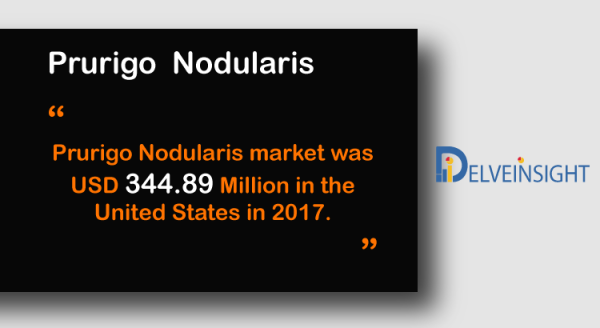
The Prurigo Nodularis market report provides current treatment practices, emerging drugs, Prurigo Nodularis market share of the individual therapies, current and forecasted Prurigo Nodularis market Size from 2017 to 2030 segmented by seven major markets. The Report also covers current Prurigo Nodularis treatment practice/algorithm, market drivers, market barriers and unmet medical needs to curate best of the opportunities and assesses the underlying potential of the market.
Some of the key facts of the report
1. The total diagnosed Prurigo Nodularis prevalent population in the 7MM was found to be 539,893 in 2017.
2. The total diagnosed prevalent patient population of Prurigo Nodularis in the 7MM was around 46.30% of the total cases in the United States in 2017.
3. Females are affected more by Prurigo Nodularis as compared to males.
Scope of the report:-
- The report covers the descriptive overview of Prurigo Nodularis, explaining its causes, signs and symptoms, pathophysiology, diagnosis and currently available therapies
- Comprehensive insight has been provided into the Prurigo Nodularis epidemiology and treatment in the 7MM
- Additionally, an all-inclusive account of both the current and emerging therapies for Prurigo Nodularis are provided, along with the assessment of new therapies, which will have an impact on the current treatment landscape
- A detailed review of Prurigo Nodularis market; historical and forecasted is included in the report, covering drug outreach in the 7MM
- The report provides an edge while developing business strategies, by understanding trends shaping and driving the global Prurigo Nodularis market
Request for sample pages @ Prurigo Nodularis market report

Prurigo Nodularis treatment is challenging. The current Prurigo Nodularis market can be classified based on the severity of the disease as mild, moderate, and severe. There is a multimodal treatment algorithm consisting of topical and systemic therapies, where topical therapies are used for treating the visible form of the disease. In contrast, systemic therapies are used for symptomatic treatment. The symptomatic therapy aims to reduce itching and complete healing of lesions. A mild form of the disease includes several topical therapies, such as antihistamines, topical corticosteroids, topical immunosuppressants, topical calcineurin inhibitors, emollients, which are recommended as both an essential therapy and general therapeutic measure.
Topical corticosteroid includes Betamethasone 0.1% cream, which reduces itch significantly, in comparison with an antipruritic moisturizing cream, and also results in nodule flattening. Topical calcineurin inhibitors or immunosuppressants represent a relatively long-term treatment option.
On the other hand, for moderate-to-severe forms of the disease, topical corticosteroids (Betamethasone 0.1%), topical Immunosuppressants/Topical calcineurin inhibitors (pimecrolimus and Tacrolimus), systemic immunosuppressants (for moderate-to-severe cases), systemic corticosteroid (triamcinolone acetonide) along with other relevant therapies such as antidepressants (paroxetine, amitriptyline or mirtazapine), gabapentinoids and opioid receptor antagonists are suggested usually.
Immunosuppressants are considered as a therapeutic option for patients with moderate-to-severe Prurigo Nodularis mainly. Several studies have described the application of immunosuppressive agents, such as cyclosporine in the disease, showing remarkable symptom improvement. During immunosuppressant therapy, it is essential to monitor blood pressure and laboratory values, especially those of the kidneys. Thalidomide and its analogue Lenalidomide are other immunomodulatory drugs that have successfully been used to treat refractory cases of Prurigo Nodularis.
The launch of the emerging therapies is expected to significantly impact Prurigo Nodularis treatment scenario in the upcoming years:-
Prurigo Nodularis Drugs
1. Serlopitant
2. Nalbuphine ER
3. Nemolizumab (CD14152)
4. Apremilast (CC-10004)
5. M 118103
6. KPL-716
7. Dupixent (Dupilumab/SAR231893)
And many others
The key players in Prurigo Nodularis market are:
1. Menlo Therapeutics
2. Trevi Therapeutics
3. Galderma
4. Amgen
5. Maruho
6. Kiniksa Pharmaceuticals
7. Sanofi
8. Regeneron Pharmaceuticals
And many others
Table of contents
1 Key Insights
2 Prurigo Nodularis Patient Overview at a Glance
3 Executive Summary
4 SWOT Analysis
5 Disease Background and Overview of Prurigo Nodularis
6 Recognized Establishments
7 Prurigo Nodularis Epidemiology and Patient Population
8 Country-wise Epidemiology of Prurigo nodularis
8.1 United States
8.2 EU5 Countries
8.3 Germany
8.4 France
8.5 Italy
8.6 Spain
8.7 United Kingdom
8.8 Japan
9 Prurigo Nodularis Treatment
10 European Guidelines on Prurigo Nodularis
11 FDA Recommendations for Prurigo Nodularis Treatment
12 Unmet Need
13 Prurigo Nodularis Emerging Drugs
13.1 Key Competitors
13.2 Serlopitant: Menlo Therapeutics
13.3 Nalbuphine ER: Trevi Therapeutics
13.4 Nemolizumab (CD14152): Galderma
13.5 Apremilast (CC-10004): Amgen
13.6 M 118103: Maruho
13.7 KPL-716: Kiniksa Pharmaceuticals
13.8 Dupixent (Dupilumab/SAR231893): Sanofi/Regeneron Pharmaceuticals
14 Prurigo Nodularis Market Size
15 Attribute Analysis
16 Conjoint Analysis
17 7MM Prurigo Nodularis Market Outlook
17.1 United States
18 EU5 Countries
18.1 Germany
18.2 France
18.3 Italy
18.4 Spain
18.5 United Kingdom
19 Japan
20 Case Reports
21 Market Drivers
22 Market Barriers
23 Appendix
24 Prurigo Nodularis Report Methodology
25 DelveInsight Capabilities
26 Disclaimer
27 About DelveInsight
Media Contact
Company Name: DelveInsight
Contact Person: Priya Maurya
Email: Send Email
Phone: +919650213330
Address:304 S. Jones Blvd #2432
City: Albany
State: New York
Country: United States
Website: https://www.delveinsight.com/

